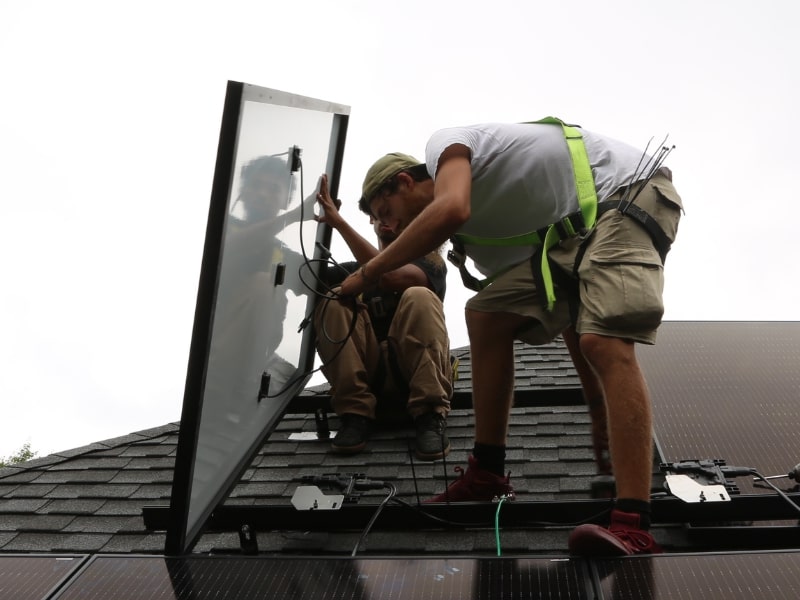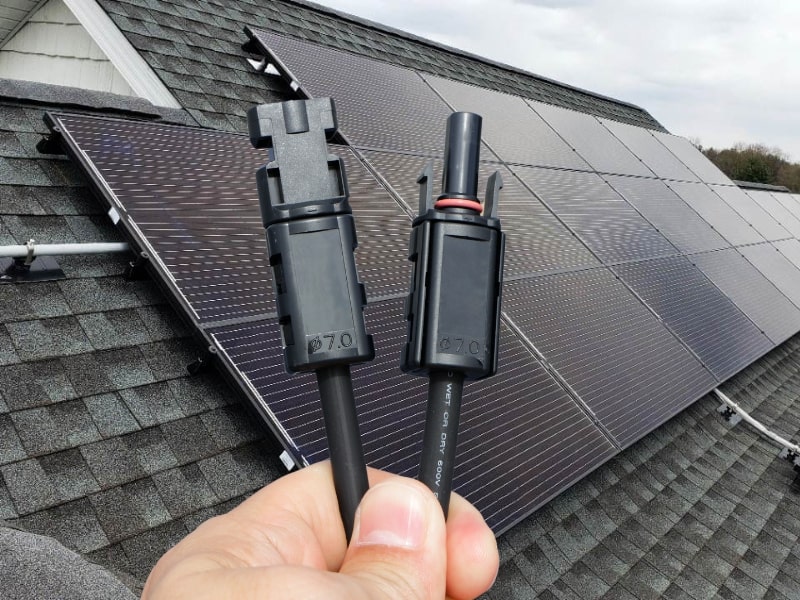Today, we’re discussing the unsung heroes in the solar industry: solar connectors.
Most of the recognition in solar goes to the panels: their power, wattage, and efficiency. As solar manufacturers race to develop the most efficient, powerful, and attractive solar panels, that’s the majority of what we see online.
Without connectors to safely distribute energy throughout solar systems, all of these solar panels might as well be, as Bruce Springsteen famously sang, “Dancing in the Dark.”
This blog will discuss the pivotal role of solar connectors in connecting and optimizing solar panels within a broader energy system. We’ll uncover the mechanisms, types, and profound impact these connectors have on solar power systems’ efficiency, safety, and overall success.

What are solar connectors?
What is the use of solar connectors?
Solar connectors are the backbone of the solar panel system, holding everything together behind the scenes. These specialized plugs enable the efficient and secure transfer of direct current (DC) power generated by solar panels to inverters or other devices within the solar power system.
Their plug-and-play design simplifies installation and maintenance processes, making them integral to the seamless functioning of solar power setups.
What solar connectors are made of?
Solar connectors are composed of materials chosen for their durability, electrical conductivity, and resistance to environmental conditions. The specific materials used to manufacture them vary among different connector manufacturers and models, though all are designed to withstand the harsh environmental conditions of outdoor installations. These are the parts of solar connectors and what they’re typically made of:
Insulating materials
The insulating materials inside solar connectors ensure electrical safety and maintain the integrity of electrical connections. Common insulating materials inside solar connectors are:
- Polycarbonate: Often used for the insulating housing of solar connectors, polycarbonate is a durable and heat-resistant plastic that provides electrical insulation while withstanding exposure to sunlight.
- Polyamide (Nylon): Another thermoplastic commonly used for insulating components, polyamide offers good mechanical strength and resistance to temperature variations.
Contact Materials
Contact materials are the parts of the connector that make contact and conduct electricity from one panel to the next. Common contact materials are:
- Copper: The conductive pins inside the connectors are typically made of copper due to its excellent electrical conductivity. Copper ensures efficient transmission of electricity between solar panels and other system components.
- Silver-Plating: Some connectors may have silver-plated copper contacts to enhance conductivity and reduce corrosion, particularly in harsh environmental conditions.
Sealing and Gaskets
Sealing and gasket components safeguard the electrical connections from environmental factors, ensuring solar connectors’ reliability and long-term performance in a wide range of outdoor settings. They provide waterproofing, environmental protection, UV resistance, and corrosion prevention.
- Ethylene Propylene Diene Monomer (EPDM): EPDM rubber is often used for seals and gaskets in solar connectors. It provides excellent resistance to weathering, UV radiation, and moisture, ensuring a watertight and durable connection.
Housing and Enclosures
Housing and enclosures are protective casings that shield the internal components of the connectors, contributing to the overall reliability and performance of solar connectors in diverse outdoor environments.
- Polybutylene Terephthalate (PBT): PBT is a thermoplastic polyester commonly used for connector housings. It offers good mechanical strength, resistance to heat, and dimensional stability.
- Polysulfone: This high-performance thermoplastic is known for its resistance to chemicals and UV radiation, making it suitable for outdoor applications.
Locking Mechanisms
Locking mechanisms secure a strong and reliable connection between the male and female components of the connectors. These mechanisms help prevent accidental disconnections that could disrupt the flow of electricity.
- Stainless Steel: Stainless steel is often used for components involved in the locking mechanism, such as springs or clips, due to its corrosion resistance and strength.
How solar connectors work
Solar connectors create a secure and efficient electrical bridge between solar panels within solar power systems. Comprising male and female components, these connectors feature various locking mechanisms, such as snap-in, twist-lock, or latch systems, ensuring a firm and reliable connection.
The connectors enable the seamless flow of direct current (DC) electricity generated by solar panels, with the male connector typically housing protruding pins and the female connector providing sockets to receive them. The connectors’ insulating materials, often made of durable plastics like polycarbonate or polyamide, protect against electrical mishaps and environmental elements. Seals and gaskets provide waterproofing, UV resistance, and corrosion prevention, while the housing and enclosures offer mechanical protection and weather resistance.
Through these design elements, solar connectors play a pivotal role in optimizing solar power systems’ efficiency, safety, and longevity, ensuring the reliable conversion of solar energy into usable alternating current (AC) electricity.
What types of solar connectors are available?
Several solar connectors are available, each designed for specific applications and requirements in solar power systems.
Here are the most commonly used types:
MC4 Connector
MC4 connectors are the go-to for residential, commercial, and utility-scale installers. The MC stands for multi-contact, and the 4 stands for the 4mm diameter contact pin inside the plug.
Because of their ease of use and reliability, these connectors have seen widespread adoption since Switzerland’s Staubli released them in 1996.
The snap-in locking mechanism of MC4 connectors simplifies the installation process, ensuring a quick and secure connection between solar panels, inverters, and other components. Their design, featuring a male connector with a protruding pin and a female connector with a socket, allows for an audible “snap” when connected.
They’re known for their weather-resistant and durable construction, making them suitable for outdoor installations. The connectors can only be disconnected by using a special unlocking tool. Their adherence to industry standards ensures compatibility across various solar technologies, contributing to their popularity in worldwide residential, commercial, and utility-scale solar projects.
Tyco Solarlok Connectors
Tyco Solarlok connectors stand out for their robust design and durability, making them suitable for projects in harsh environmental conditions, including extreme temperatures and challenging climates. They’re designed to carry high current levels, making them the top choice for larger-scale utility-scale projects.
These connectors feature a snap-in locking mechanism, similar to MC4 connectors, providing a secure and efficient connection.
Amphenol H4 Connectors
Amphenol Helios 4 connectors, also known as H4 connectors, are commonly used in utility-scale and large-scale commercial projects due to their durability and high current-carrying capacity. The H4 in the name refers to the four-millimeter diameter of the contact pin.
What sets H4 connectors apart is their unique design and construction. The connectors feature a secure locking mechanism that ensures a tight and stable connection, minimizing the risk of accidental disconnection. The 4 mm connectors are designed to accommodate larger wire gauges, making them suitable for high-power applications.
T4 Connectors
After Canadian Solar introduced its T4 connector to the e North American market in 2016, it established itself for its compatibility with harsh environmental conditions.
They carry a high electricity load and resist UV radiation, extreme temperatures, and moisture, making them suitable for a wide range of outdoor solar installations. They are similar in design and installation to MC4 connectors.
How do I compare solar connectors?
You can use several important measurements to compare solar connectors head to head.
These are:
Current Rating
The current rating, measured in amperes (A), indicates the maximum electrical current that a connector can safely carry. Choosing connectors with current ratings that match or exceed the expected current in the solar power system is crucial to prevent overheating and ensure safety.
Voltage Rating
The voltage rating, measured in volts (V), specifies the maximum voltage the connector can handle. Selecting connectors with an appropriate voltage rating is essential to prevent electrical breakdown and maintain the integrity of the connection.
Wire Size Compatibility
Solar connectors are designed to accommodate specific wire sizes. Ensuring compatibility between the connector and the wire gauge used in the solar installation is crucial for establishing secure connections and preventing overheating or poor conductivity issues.
IP (Ingress Protection) Rating
The IP rating indicates the level of protection against dust and moisture. A higher IP rating signifies better protection. This is particularly important for outdoor installations where connectors are exposed to varying weather conditions.
Temperature Rating
The temperature rating indicates the range of temperatures within which the connector can operate safely. It is essential to choose connectors with temperature ratings that align with the expected environmental conditions of the solar installation.
Contact Resistance
Contact resistance measures the opposition to the flow of electric current through the connector. Lower contact resistance is desirable as it minimizes energy losses and ensures efficient power transmission.
Materials and Construction
Consider the materials used in constructing the connector, especially the insulating and contact materials. These materials should be durable, weather-resistant, and capable of withstanding the environmental conditions of the installation site.
Locking Mechanism
The type of locking mechanism is important for ease of installation and the stability of the connection. Common locking mechanisms include snap-in, twist-lock, latch, and push-pull mechanisms.
Standards Compliance
Ensure the connectors comply with industry standards, such as IEC 62852 for connectors and IEC 61730 for photovoltaic modules. Adherence to standards ensures compatibility and interoperability within the solar power system.
Considering these measurements and specifications ensures that the selected solar connectors are suitable for the specific requirements and conditions of the solar installation, contributing to the overall efficiency and safety of the system.
Which connector is right for my project?
The choice of a specific connector type depends on factors such as the size of the solar installation, environmental conditions, and system compatibility. It’s important to adhere to industry standards and ensure that connectors from different manufacturers are compatible for seamless integration within a solar power system. You should always consult directly with manufacturers and suppliers and review spec sheets before starting your project.
The bright idea
Solar connectors serve as conduits, ensuring the efficient transmission of electricity generated by solar panels. Choosing the right connectors involves carefully considering current and voltage ratings, wire size compatibility, environmental resilience, and adherence to industry standards. By selecting connectors that align with the installation’s specific requirements, users can establish reliable and secure electrical connections, contributing to the overall performance of the solar array.
The right solar connectors facilitate the seamless flow of solar energy and play a crucial role in enhancing the safety, reliability, and overall success of solar power projects, whether they are residential, commercial, or utility-scale installations.
Questions about which solar connectors are right for your job? Or just looking for more information? Contact one of our experts today.

